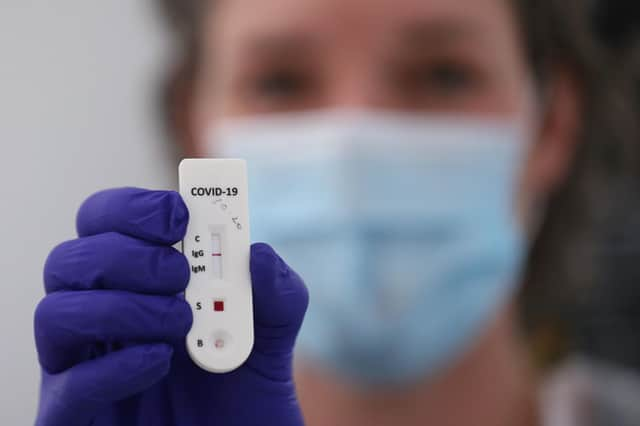Covid spread at ‘highest ever’ in Northern Ireland as Executive agrees to keep status quo


It means current rules regarding socialising over the holiday period remain in place, but – to the relief of most parents – children will return to schools as planned in the first week of January.
Following the meeting First Minister Paul Givan confirmed via a Tweet that ministers agreed to leave things as they were.
Advertisement
Hide AdAdvertisement
Hide AdHe said the Executive will continue to assess the data as more information emerges.


Later yesterday evening an official statement was released by the Executive Office, who said “the levels of COVID-19 circulating in the community are at the highest rate they have ever been” due to the rapidly spreading Omicron variant.
The statement said: “The Executive has agreed that the current package of COVID-19 measures remains a proportionate response to the Omicron variant at this time.
“While the situation remains under continuous review, the Executive has agreed not to introduce additional restrictions following its latest considerations.”
Advertisement
Hide AdAdvertisement
Hide AdIt confirmed the self-isolation period will reduce from 10 to 7 days subject to a negative lateral flow test on day six and a second negative lateral flow test taken at least 24 hours later on day seven.
The Executive Office said: “Omicron became the dominant variant of COVID-19 before Christmas Day and the daily infection rate has increased dramatically in the last week. It now accounts for around 90 per cent of cases here.
While there remains a great deal of uncertainty about Omicron, there is some encouragement from initial research which suggests it may be less severe than the Delta variant in terms of the proportion of infected people requiring hospitalisation.
“Further data on illness severity will emerge in the next one to two weeks and this will help further inform the modelling and the Executive’s considerations.
Advertisement
Hide AdAdvertisement
Hide Ad“However, the high infection rate of Omicron will lead to more hospitalisations and additional pressures on hospitals.
“Widespread community transmission will inevitably lead to more staff absences in essential services and so it is important not to drop our guard and that everyone continues to make safer choices to keep themselves and others safe.
“In particular, we want people to remain cautious and enjoy the New Year as safely as possible. That means taking a lateral flow test if you intend to meet up with others. Meet outdoors if possible or in well ventilated rooms if meeting indoors and limit the number of people you come into contact with.”
Mr Givan said the approach is the right one at this time: “This recognises that Omicron is now the dominant strain in Northern Ireland with over 90% of all new cases, and it is more transmissible, having a detrimental impact on the availability of staff within public and private sector organisations.
Advertisement
Hide AdAdvertisement
Hide Ad“It is critical that we can continue to deliver those key services to the public and this new policy is the right approach at this time.”
Yesterday ministers heard that the Omicron variant was estimated to be accounting for 90% of cases in the region.
Department of Health modelling data seen by the PA news agency, which was presented to ministers, indicated that while the Delta variant was expected to gradually decline, with a “more modest Delta epidemic” persisting in parallel with a larger Omicron outbreak.
It set out that a peak in numbers would occur in early to mid-January/early February, with hospital admissions and occupancy peaking in late January/early February.
Advertisement
Hide AdAdvertisement
Hide AdThe extent of the peak would depend on the severity of illness with Omicron.
Officials were said to be closely monitoring data emerging from Northern Ireland, as well as the experience in England and Scotland.
Ministers were told that if Omicron was associated with illness as severe as Delta, “significant intervention” would be required to keep hospital inpatient numbers at less than 1,000.
But if the severity of Omicron was substantially reduced from that seen with Delta, close to an 80% reduction, current measures could be sufficient.
——— ———
A message from the Editor:
Advertisement
Hide AdAdvertisement
Hide AdThank you for reading this story on our website. While I have your attention, I also have an important request to make of you.
With the coronavirus lockdown having a major impact on many of our advertisers — and consequently the revenue we receive — we are more reliant than ever on you taking out a digital subscription.
Subscribe to newsletter.co.uk and enjoy unlimited access to the best Northern Ireland and UK news and information online and on our app. With a digital subscription, you can read more than 5 articles, see fewer ads, enjoy faster load times, and get access to exclusive newsletters and content. Visit https://www.newsletter.co.uk/subscriptions now to sign up.
Our journalism costs money and we rely on advertising, print and digital revenues to help to support them. By supporting us, we are able to support you in providing trusted, fact-checked content for this website.
Ben Lowry
Editor